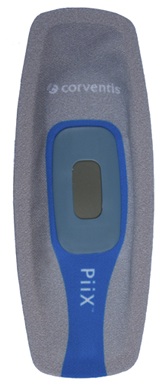 Big news for the first startup shepherded by the West Wireless Health Institute: The FDA has greenlit Corventis' Nuvant system, a mobile cardiac telemetry system. The 510(k) clearance for Nuvant enables Corventis to begin marketing the service in the U.S. -- Corventis secured FDA clearance for its PiiX sensor (pictured), which is a part of the Nuvant system -- last April. According to the company, it has also secured approval from the Centers for Medicaid and Medicare (CMS) for its monitoring facility and is now able to bill for services provided to patients with Medicare.
Big news for the first startup shepherded by the West Wireless Health Institute: The FDA has greenlit Corventis' Nuvant system, a mobile cardiac telemetry system. The 510(k) clearance for Nuvant enables Corventis to begin marketing the service in the U.S. -- Corventis secured FDA clearance for its PiiX sensor (pictured), which is a part of the Nuvant system -- last April. According to the company, it has also secured approval from the Centers for Medicaid and Medicare (CMS) for its monitoring facility and is now able to bill for services provided to patients with Medicare.
The Nuvant services look to fall under the same billing code for mobile cardiac telemetry as CardioNet's MCOT system and LifeWatch's MCOT system. Reimbursement for mobile cardiac telemetry services took a blow last year when CMS decreased the reimbursement rate for the services by about 33 percent: From $1123 to $754.
The most obvious difference between the solutions listed above is device form factor:
Corventis' system uses a peel-and-stick, band-aid like sensor, called PiiX instead of a device that straps on to and around the patient's torso or a medallion device worn about the neck with multiple leads attached to it.
Corventis' stated service description for Nuvant: "With a specific focus on ambulatory arrhythmia monitoring, the NUVANT MCT System leverages the low profile form factor, advanced algorithms and multi-sensor capabilities of the PiiX wearable platform to enable continuous monitoring for a broad set of arrhythmias, including atrial fibrillation, as well as patient falls that may be associated with arrhythmias. Patients can also trigger the collection of an electrocardiogram (ECG), on-demand, upon experiencing symptoms, further aiding in the correlation of symptoms with the ECG."
So where does all the data go? Corventis explains that the ECGs are transmitted to the Corventis Monitoring Center via the company's wireless-enabled zLink. The data is then reviewed and a response is assessed by trained cardiographic technicians. Physicians receive notification of urgent events as well as actionable information in the form of Episode Reports, Daily Reports and End of Use Reports via fax, email and/or the secure Corventis website. Physicians can then use the info to diagnose symptomatic and asymptomatic cardiac arrhythmias and proactively manage patients remotely from anywhere, according to the company.
“The NUVANT MCT System represents the next generation of noninvasive, ambulatory arrhythmia monitoring,” stated Leslie Saxon, M.D., chief, division of cardiology, Keck School of Medicine at the University of Southern California, Los Angeles, who is the founder of the annual Body Computing Conference and a pioneer in the field of networked medical devices. “By incorporating comprehensive algorithms and patient-activation functionality into the inconspicuous PiiX, NUVANT provides outstanding arrhythmia detection capabilities so physicians can more effectively identify even challenging suspected rhythm disturbances for diagnosis and treatment. Thus far, I have not seen a wireless cardiovascular system that works this well both for physicians and for patients.”
For more, read this press release from Corventis


















